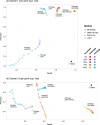Inferring hierarchical orthologous groups from orthologous gene pairs
- PMID: 23342000
- PMCID: PMC3544860
- DOI: 10.1371/journal.pone.0053786
Inferring hierarchical orthologous groups from orthologous gene pairs
Abstract
Hierarchical orthologous groups are defined as sets of genes that have descended from a single common ancestor within a taxonomic range of interest. Identifying such groups is useful in a wide range of contexts, including inference of gene function, study of gene evolution dynamics and comparative genomics. Hierarchical orthologous groups can be derived from reconciled gene/species trees but, this being a computationally costly procedure, many phylogenomic databases work on the basis of pairwise gene comparisons instead ("graph-based" approach). To our knowledge, there is only one published algorithm for graph-based hierarchical group inference, but both its theoretical justification and performance in practice are as of yet largely uncharacterised. We establish a formal correspondence between the orthology graph and hierarchical orthologous groups. Based on that, we devise GETHOGs ("Graph-based Efficient Technique for Hierarchical Orthologous Groups"), a novel algorithm to infer hierarchical groups directly from the orthology graph, thus without needing gene tree inference nor gene/species tree reconciliation. GETHOGs is shown to correctly reconstruct hierarchical orthologous groups when applied to perfect input, and several extensions with stringency parameters are provided to deal with imperfect input data. We demonstrate its competitiveness using both simulated and empirical data. GETHOGs is implemented as a part of the freely-available OMA standalone package (http://omabrowser.org/standalone). Furthermore, hierarchical groups inferred by GETHOGs ("OMA HOGs") on >1,000 genomes can be interactively queried via the OMA browser (http://omabrowser.org).
Conflict of interest statement
Figures

 are drawn in orange. By definition, these groups correspond to the sets of leaves attached to the speciation nodes of the gene tree coloured in orange.
are drawn in orange. By definition, these groups correspond to the sets of leaves attached to the speciation nodes of the gene tree coloured in orange.
 (right). Lemma 1 establishes the one-to-one correspondence between
(right). Lemma 1 establishes the one-to-one correspondence between  and
and  (which we prove by viewing it as composition of the one-to-one correspondences
(which we prove by viewing it as composition of the one-to-one correspondences  and
and  ).
).

 parameter values for GETHOGs and bootstrap value for COCO-CL.
parameter values for GETHOGs and bootstrap value for COCO-CL.
 and bootstrap
and bootstrap ). The points for EggNOG and OrthoDB are from the original analysis (Reference [9],table 2).
). The points for EggNOG and OrthoDB are from the original analysis (Reference [9],table 2).Similar articles
-
Orthologous Matrix (OMA) algorithm 2.0: more robust to asymmetric evolutionary rates and more scalable hierarchical orthologous group inference.Bioinformatics. 2017 Jul 15;33(14):i75-i82. doi: 10.1093/bioinformatics/btx229. Bioinformatics. 2017. PMID: 28881964 Free PMC article.
-
Identifying orthologs with OMA: A primer.F1000Res. 2020 Jan 17;9:27. doi: 10.12688/f1000research.21508.1. eCollection 2020. F1000Res. 2020. PMID: 32089838 Free PMC article.
-
Inferring Orthology and Paralogy.Methods Mol Biol. 2019;1910:149-175. doi: 10.1007/978-1-4939-9074-0_5. Methods Mol Biol. 2019. PMID: 31278664
-
Inferring orthology and paralogy.Methods Mol Biol. 2012;855:259-79. doi: 10.1007/978-1-61779-582-4_9. Methods Mol Biol. 2012. PMID: 22407712 Review.
-
The quest for orthologs: finding the corresponding gene across genomes.Trends Genet. 2008 Nov;24(11):539-51. doi: 10.1016/j.tig.2008.08.009. Epub 2008 Sep 24. Trends Genet. 2008. PMID: 18819722 Review.
Cited by
-
MBGD update 2018: microbial genome database based on hierarchical orthology relations covering closely related and distantly related comparisons.Nucleic Acids Res. 2019 Jan 8;47(D1):D382-D389. doi: 10.1093/nar/gky1054. Nucleic Acids Res. 2019. PMID: 30462302 Free PMC article.
-
New bobtail squid (Sepiolidae: Sepiolinae) from the Ryukyu islands revealed by molecular and morphological analysis.Commun Biol. 2019 Dec 11;2:465. doi: 10.1038/s42003-019-0661-6. eCollection 2019. Commun Biol. 2019. PMID: 31840110 Free PMC article.
-
Enabling semantic queries across federated bioinformatics databases.Database (Oxford). 2019 Jan 1;2019:baz106. doi: 10.1093/database/baz106. Database (Oxford). 2019. PMID: 31697362 Free PMC article.
-
Adaptive selection in the evolution of programmed cell death-1 and its ligands in vertebrates.Aging (Albany NY). 2020 Feb 11;12(4):3516-3557. doi: 10.18632/aging.102827. Epub 2020 Feb 11. Aging (Albany NY). 2020. PMID: 32045365 Free PMC article.
-
Big data and other challenges in the quest for orthologs.Bioinformatics. 2014 Nov 1;30(21):2993-8. doi: 10.1093/bioinformatics/btu492. Epub 2014 Jul 26. Bioinformatics. 2014. PMID: 25064571 Free PMC article.
References
-
- Fitch WM (1970) Distinguishing homologous from analogous proteins. Syst Zool 19: 99–113. - PubMed
-
- Altenhoff AM, Dessimoz C (2012) Inferring orthology and paralogy. In: Anisimova M, editor, Evolutionary Genomics, Clifton, NJ, USA: Methods in Molecular Biology. 259–279. - PubMed
-
- Wall DP, Fraser HB, Hirsh AE (2003) Detecting putative orthologs. Bioinformatics 19: 1710–1711. - PubMed
Publication types
MeSH terms
LinkOut - more resources
Full Text Sources
Other Literature Sources

